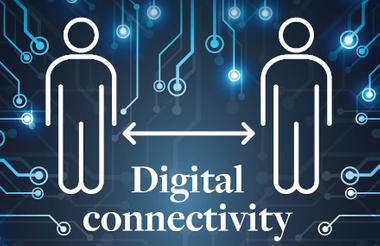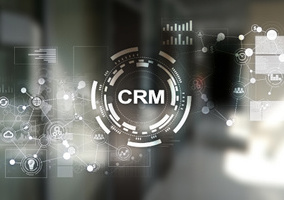The challenges brought since the pandemic hit over two years ago have been well documented. But what issues remain for charities, and what lessons have been learned about the importance of customer relationship management (CRM) systems?
Phil Hunt, senior manager, demand marketing at Blackbaud Europe, says that the fundraisers his organisation speaks to identify their biggest challenges as the general UK economic situation, and adapting to new ways of fundraising – driven in part by a move to online or digital-first methods. He cites statistics from Blackbaud’s annual Status of UK Fundraising survey, which finds that 64% of respondents say that in-person events contribute less now than before the pandemic.
“However, organisations with the right tech perform better, with 43% of organisations with a CRM saying that their income increased year-over-year compared to a third without,” Hunt says. “And organisations using CRM software are more likely to be gaining supporters – 43% compared to 38%.”
Keith Collins, principal consultant at Adapta Consulting, says that as well as trying to plug gaps in events fundraising income, many charities embraced digital innovation during the pandemic, either in terms of new ways of using digital for fundraising, or new ways of engaging with service users using digital tools. “The challenges now are in retaining the best of these innovations, and making them work alongside the approaches they had taken to fundraising, service delivery and internal collaboration before the pandemic. For CRM, the key lesson learned is that solutions need to work alongside these various other technologies and help support modern, often digital, customer experiences. Many organisations are finding that the challenge of integrating ageing CRM systems with the wider digital, data and tech estate is where things fall down. Therefore, many are now starting their search for their next CRM system in earnest.”
Tom Ellis, managing director at Harlequin, explains that like most people, its clients worked from home during the lockdowns but in recent months this has morphed into hybrid working. “People have become used to remotely accessing their systems using the cloud/web. With restrictions on traditional means of meeting up with supporters, such as at events or other gatherings, supporter relationships have had to be maintained at arm’s length. CRMs have been an invaluable resource to achieve this.”
Chris Houghton, CEO at Beacon, adds that the cloud is not an extra feature anymore; it is essential. “And that applies to every tool – from Microsoft Office to CRMs.”
Ivan Wainewright, independent CRM consultant, thinks that those who have on-premise databases are still struggling to provide simple and fast enough access for most staff who work from home, whereas cloud CRM systems provide such access automatically. “Systems which enable better digital communications, and those which can quickly be configured for new requirements, are showing their benefits. Some organisations are still struggling with the non-centralised location of supporter services and income processing, but many have used technology well.”
Steve Cast, managing director at Redbourn, says that without doubt, those customers who were already based in the cloud had the advantage when lockdowns first started. “That agility in the working environment has come with its own set of issues, security being perhaps one of the most noticeable. For example, charities should ensure that they are running an encrypted connection, using strong, secure password phrases, or better still, using multi-factor authentication as the preferred route. Strengthening security for a disparate workforce is a valuable lesson that customers have had to learn and adapt to in a short space of time.”
He continues: “CRM has never been more important. With a distributed workforce, working from home, it is vital that up-to-date records are maintained. Every telephone call, every email received or sent, every letter scanned, should be logged as communications against the supporter’s record. That way, the entire team is aware of the ongoing discussion being had with the supporter. Accurate data has never been more important. We are seeing changes in the frequency of data cleaning. Ownership of data is shifting too, with a demand for online data to be captured direct into the CRM, and not captured (and eventually shared) by third-party services.”
Robin Fisk, founder and CEO at Donorfy, says that the pandemic emphasised the importance of CRM. “Whether that’s pivoting from in-person events, running emergency appeals or simply keeping the CRM updated so that everyone can trust it when they log in, the pandemic increased dependence not only on the CRM itself but also on the CRM supplier to guide and advise charities on the best way to use their CRM given the changing circumstances.”
All change?
Proposed legislative changes to the UK General Data Protection Regulation (GDPR) and to the Privacy and Electronic Communications Regulations (PECR) in the wake of Brexit are generally aimed at reducing certain compliance burdens that the law places on organisations. There is a mixed level of knowledge among respondents to our survey about these proposed changes with 57% saying they are aware of them. Of those, however, over 80% feel that they will make no difference (see figures 8 and 9 in PDF at bottom of the article).
So, what are the main things charities need to potentially be prepared for? Ellis thinks that in essence the proposed changes are advantageous to charities, which were “previously tethered by the fear of breaching data regulations”. He cites the proposed introduction of the soft opt-in policy, which will allow more freedom for a charity to contact previous supporters and send fundraising emails. For example, if a donor expresses interest in a fundraising campaign or makes a donation, a charity would no longer need to obtain explicit consent from the donor to send them related fundraising emails. “I would assume, therefore, that charities will need to prepare for accelerated growth in their supporter database and, via research, run targeted campaigns.”
Hunt says that another significant proposed change would allow organisations to use analytics cookies – tracking data such as the number of users on a site and duration of site visits, and similar technologies without obtaining the user’s consent, which would only be required for cookies that track users and create profiles, as in online advertising.
He also raises a proposed reform to remove the record-keeping requirement under Article 30 of the UK GPDR, leaving it up to organisations to determine how best to demonstrate compliance.
“Under these proposed changes, organisations that can demonstrate a proactive approach to compliance and accountability would be able to provide the Information Commissioner’s Office (ICO) with a remedial action plan in the event of an infringement of the UK GPDR. The ICO could then accept this without taking any further action against the organisation. These changes would encourage charities to develop their own privacy and compliance programmes that fit their organisation’s needs and goals.”
Fisk adds that it will be important to check through vendors’ data processing agreements to make sure they have the standard contractual clauses needed to protect charities when their data is transferred outside the EU and UK.
David Membrey, principal consultant at Adapta Consulting, thinks that most of the proposed changes are quite abstruse. “The one most likely to trip up some charities is that you now need a partner within the EU to act as your agent if you have a significant number of data subjects based there. This could be an established partner charity with which you already work, or possibly the EU branch of a multinational law firm.”
His observation is that many charities seem to have taken their eye off the ball when it comes to data protection. “Having been through the process of preparing for GDPR they have failed to take forward those elements of data protection that they had previously put to one side. Two very glaring omissions are that most charities have failed to keep their privacy notice up to date, or worse, make it very hard to find. And very few charities carry out a data protection impact assessment, which clearly meets the criteria, at the start of a large project.”
Cast thinks that while we will continue to see a strong degree of overlap and interoperability between the UK and EU GDPR, for smaller charities, the potential changes to limit the scope of subject access requests will be welcome. “As will any change relating to a widening or clarification around legitimate interest. For now, charities should ensure that they continue to adhere to EU/UK GDPR, while setting aside time and resource for later in the year to carry out a review and adjustment to their data protection compliance model. There is, of course, a concern that this could be unsettling in a period of what feels like almost constant change. But as every good Scout would say: ‘Be prepared’.
Maximising use
A common theme in comments by survey respondents is one of getting the best out of their CRM system. One says: “Staff do not use the CRM properly – they find it cumbersome,” although they concede that this is probably a training issue. Another bemoans the lack of time to upload historical data, and again, pinpoints a need for “skills training and consultancy for improvements in the way we use the CRM as no one had any experience prior to its installation”. In general, while CRM systems have a huge benefit, a lot of charities do not have the time and expertise to optimise their usage.
“As CRM systems become more functional there is always the risk that not all of the features are understood, or even used,” says Cast. He picks up on the training issue, and what he calls a worrying trend, particularly through the pandemic, of a decline in training investment budgets. “This is key to ensuring that charities make the most of their significant investment in systems and staff. It feels like a no-brainer to ensure that your team knows the full capabilities of the CRM system, and is taught how to use it effectively. However intuitive CRM systems are, there is still no substitute for investing in focused training, delivered by experts.”
Wainewright feels that contemporary CRM platforms have amazing capacity to offer more to charities. “But I don’t think that most charities are capitalising on such benefits. For example, very few I know of are creating automated, responsive supporter journeys, although they could do.”
Fisk agrees that there is always more that you can do. “True scalability lies in knowing what works and doing more of it. The answer to what works, and what doesn’t, is probably in your CRM. So charities could gain a lot by analysing their data, or asking their vendor to help if they don’t have the skills or capacity in-house.”
Ellis has noticed a trend for more functionality to expand the use of a CRM system across all aspects of a charity’s work. “There are obvious advantages to be had when the CRM system is the hub around which everything flows. There is an ongoing onus on the CRM provider to create a channel of communication with clients to keep them updated on new features, and to take on board new ideas from them.” Collins says that he genuinely thinks that charities are now expecting more from their CRM system, and are less willing to put up with something inadequate. “For many, the problem actually is that their needs and requirements go beyond what their existing CRM system is capable of – in particular in terms of integrating with data and other tools to provide an excellent experience for supporters, and efficient business tools and processes.”
For Hunt, organisations that make the most of their CRM understand the importance of a digital-first culture. “They know that understanding data is vital at every level from the board down, and that their CRM solution is only as strong as the quality of data entered. The good news is that this means organisations of all sizes can be effective users of technology infrastructure, if they have a culture that supports this. You don’t need to be a large organisation to get the most from a CRM.”
Houghton sums up by saying there’s a risk of seeing a CRM project as finished once the fundraising processes are set up. “Over time, things can grow stale – and the system becomes less and less useful. Your CRM should grow and adapt with your charity over time, so it’s important to keep asking how your CRM can help you do things better.”
Looking ahead
With regards to developments in CRM systems, Ellis says that automation and integration are often requested by clients. “We are constantly developing new means of automating tasks, utilising API processes with third-party software, introducing payment portals and integrating with social media and fundraising platforms. In today’s society, where information is king, the CRM system is the crown jewel.”
Fisk thinks that machine learning can offer charities with reasonably large databases real insights into supporters’ propensity to respond to the various kinds of outreach that charities do.
Houghton says that without a doubt, CRMs will keep getting easier to use, and more automated. “No one wants to use a product that looks like Windows 98 anymore. Charities want a system that’s actually easy to use, where they don’t have to spend hours a week on manual data entry. CRM systems that don’t keep up will be left behind.”
Collins thinks that the future will see CRM systems being seen as just one of a number of solutions that need to combine with other tools, such as RPA (robotic process automation), customer data platforms, digital marketing solutions, and discrete tools to support campaigning or volunteering – all supported by enhanced AI capabilities.
“To some extent the CRM system itself might become less mission critical, with less of a charity’s activities, processes or engagement driven specifically from that technology solution. However, the selection of an appropriate CRM solution and implementation partner will still be vital – the CRM system will continue to play an important role as part of a wider data/tech/digital ecosystem that will, together, provide that mission critical resource, and support improved experiences for supporters, beneficiaries, volunteers and staff.”
Cast says that the attention now needs to be on cyber security. “With the increased threat level following on from events in Ukraine, we should all be vigilant and on the lookout for phishing attacks, denial of service attacks and the potential threat of loss of data and income due to ransomware. Ensure that your CRM is secured, that regular point-in-time backups are taken and that you have tested your security protocols and your business continuity model. Be vigilant, as it is a case of when you will be attacked, not if. Hoping that being a not-forprofit means you are immune to cyber crime is sadly misguided.”
Wainewright concludes that the move to a CRM platform from a fundraising database is still a huge cultural shift and a massive programme of change for many organisations. “There needs to be a consideration of whether the history and reliance on direct marketing is still relevant compared to digital marketing, which it will be for some charities. But for others, it is the opportunity to embrace change and how CRM and technology can help improve communications, interactions, business processes and data analytics.
Methodology and market share
Fundraising Magazine, in partnership with Charity Finance, runs an annual survey of the UK charity CRM universe. The 2022 survey was completed by 610 charities, of which more than 450 identified as fundraising organisations, covering a wide range of incomes (see figure 1). Blackbaud continues to dominate the market, particularly for larger charities, with its long-established Raiser’s Edge product, and it has started to introduce Blackbaud CRM for larger organisations. Beacon remains popular for medium-sized and smaller charities, while Donorfy has consolidated its already strong presence by picking up lots of new clients across all ranges (see figure 3).
Related articles











